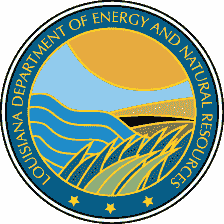Office of Conservation
Plant Research May Help Save Louisiana Wetlands
The Louisiana Department of Natural Resources has teamed with the U.S. Geological Survey National Wetlands Research Center and the University of Southwestern Louisiana to identify and duplicate exceptional native plants and then disperse them in the field to combat wetland loss.
"In every population of plants, just like the human population, there are some exceptional individuals. These are fast-growing plants that can withstand many different environmental conditions. We hope these plants will help restore Louisiana's coastal marshes," said Dr. Carroll Cordes, an NWRC branch chief.
This innovative research is part of the Biomass Production Program. In this program, federal agencies and state universities will test the hypothesis that, under the right conditions, marsh vegetation can grow faster than the coast subsides.
DNR Secretary Jack Caldwell visited NWRC in Lafayette, La., Thursday, Sept. 17, to observe the progress being made by the center and USL on the project. Caldwell has been active in coastal restoration projects since his appointment by Governor Foster in 1996.
Caldwell said, "For the first time we are applying hard science to find ways to speed up growth of marsh vegetation. This is a win-win experiment. The pay off could be huge, but even if it's not, we're going to learn a lot more about the marsh in the process."
Louisiana's fragile coastal areas are experiencing high rates of wetland loss with up to 35 square miles of coastal wetlands disappearing each year, according to Dr. Robert Stewart, Jr., NWRC director. He added, "Secretary Caldwell is action oriented and is one of those rare administrators who can develop management concepts on how to restore coastal Louisiana and implement them."
NWRC's Dr. Rebecca Howard has already begun collecting native plants from public lands from the western portion of Louisiana all the way over to the Mississippi delta. She is establishing experimental plant populations in controlled greenhouse studies to identify what Cordes calls the "super plants."
The Center has had previous success identifying and duplicating plants that can withstand coastal problems such as saltwater intrusion, according to another NWRC branch chief, Dr. Virginia Burkett.
"While researching the influence of sea-level rise on coastal wetlands, we noticed that some baldcypress trees appeared more tolerant of salt water than others. We performed experiments in the greenhouse on seeds from these trees and found that some trees did inherit what appears to be a superior ability to tolerate low levels of chronic saltwater intrusion," Burkett said.
These promising results were later confirmed in the field by Louisiana State University researchers who planted these "families" of baldcypress in several "swamp renewal" projects in south Louisiana.
Also under the Biomass Production Program, Dr. Robert Twilley from USL is studying the Caernarvon outfall area in St. Bernard Parish, a successful marsh restoration site. Other research is being conducted by the Natural Resources Conservation Service and LSU.
The National Wetlands Research Center in Lafayette is one of 16 biological research facilities of the U.S. Geological Survey. The facility is housed with state-of-the-art capabilities in wetlands research.
As the nation's largest water, earth and biological science and civilian mapping agency, the USGS works in cooperation with more than 2,000 organizations across the country to provide reliable, impartial, scientific information to resource managers, planners and other customers. This information is gathered in every state by USGS scientists to minimize the loss of life and property from natural disasters, contribute to the sound conservation, economic and physical development of the nation's natural resources and enhance the quality of life by monitoring water, biological, energy and mineral resources.
Editors: For more information, contact Gaye Farris at (318) 266-8550.
News Archives »